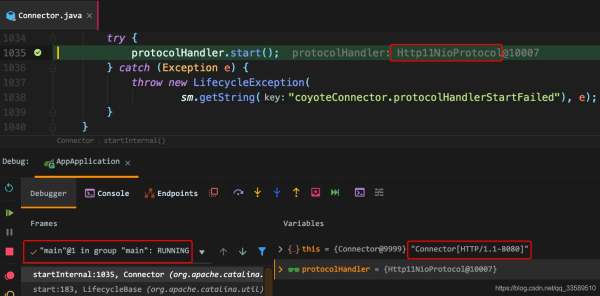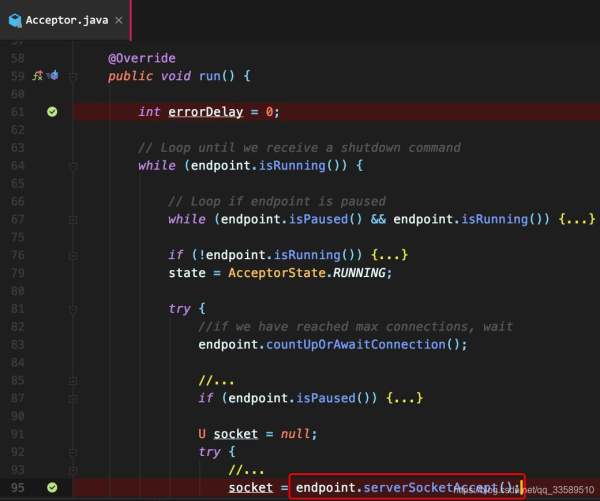这篇文章主要介绍了SpringBoot应用启动内置Tomcat的过程分析,本文给大家介绍的非常详细,对大家的学习或工作具有一定的参考借鉴价值,需要的朋友可以参考下
Connector启动过程
Connector是Tomcat提供的类。
// 通过此 Connector 开始处理请求 @Override protected void startInternal() throws LifecycleException { // Validate settings before starting if (getPortWithOffset() <0) { throw new LifecycleException(sm.getString( "coyoteConnector.invalidPort", Integer.valueOf(getPortWithOffset()))); } setState(LifecycleState.STARTING); try { // 核心动作 protocolHandler.start(); } catch (Exception e) { throw new LifecycleException( sm.getString("coyoteConnector.protocolHandlerStartFailed"), e); } }springboot默认会在8080端口提供 HTTP 服务,所以这里是一个处理HTTP协议请求的 Http11NioProtocol 实例,使用 NIO 方式处理 HTTP 协议。
Connector 对HTTP请求的接收和处理并非亲自完成,而是委托该 Http11NioProtocol protocolHandler 完成

而 protocolHandler 又进一步将请求处理工作交给 NioEndpoint 完成。
AbstractProtocol
@Override public void start() throws Exception { if (getLog().isInfoEnabled()) { getLog().info(sm.getString("abstractProtocolHandler.start", getName())); logPortOffset(); } endpoint.start(); monitorFuture = getUtilityExecutor().scheduleWithFixedDelay( new Runnable() { @Override public void run() { if (!isPaused()) { startAsyncTimeout(); } } }, 0, 60, TimeUnit.SECONDS); }调用链 :
- Connector.start()
- startInternal()
- Http11NioProtocol protocolHandler.start();
- Http11NioProtocol 的 start方法,由基类 AbstractProtocol 提供实现。它们都是tomcat提供的类。
- NioEndpoint endpoint.start()
start成员变量endpoint,一个 NioEndpoint 实例。Http11NioProtocol 类实例也并非最终处理请求,具体这些请求的处理都委托给了 NioEndpint endpoint 来完成

AbstractEndpoint
public final void start() throws Exception { if (bindState == BindState.UNBOUND) { bindWithCleanup(); bindState = BindState.BOUND_ON_START; } startInternal(); }可见 tomcat 的三种模式,默认使用 NIO 模式。
@Override public void bind() throws Exception { initServerSocket(); setStopLatch(new CountDownLatch(1)); // Initialize SSL if needed initialiseSsl(); selectorPool.open(getName()); } protected void initServerSocket() throws Exception { if (!getUseInheritedChannel()) { // 建立服务套接字 serverSock = ServerSocketChannel.open(); socketProperties.setProperties(serverSock.socket()); InetSocketAddress addr = new InetSocketAddress(getAddress(), getPortWithOffset()); // 绑定到指定端口 serverSock.socket().bind(addr,getAcceptCount()); } else { // Retrieve the channel provided by the OS Channel ic = System.inheritedChannel(); if (ic instanceof ServerSocketChannel) { serverSock = (ServerSocketChannel) ic; } if (serverSock == null) { throw new IllegalArgumentException(sm.getString("endpoint.init.bind.inherited")); } } // 设置 serverSock 为阻塞模式 serverSock.configureBlocking(true); //mimic APR behavior }serverSocket配置的是阻塞模式,明明默认使用NIO 模式,为何还要设置阻塞模式呢?
为什么使用NIO,因为BIO的accept是阻塞方法,write和read也都是阻塞的。只能当新连接到来时,去创建新线程去处理这个连接。如此,最大问题是不能同时处理大量连接,因为大量连接带来的是创建很多线程,大量线程很容易让操作系统崩溃,而且虽然并发度很高,但是很多线程都在空转,很多时间都浪费在线程空跑和线程切换上,效率也很差。
于是诞生了NIO。
其实处理连接的操作不必放在后台线程,因为后台线程很可能会处理连接建立不及时,不如将其置于主线程,增加并发度(虽然优势并不是特别明显)。
重点关心的是连接建立后获得的与客户端交互的那个socket,它的操作必须是非阻塞的,这很显然。因为在处理长连接时,我们关心的是在本次连接之内数据的读写。
NioEndpoint 正在使用阻塞模式的 ServerSocketChannel 以使其阻塞并等待连接传入,并且只有在accept后,才以非阻塞方式处理此传入的socket channel (见setSocketOptions 方法)。
正如作者指出的那样,使 ServerSocketChannel 成为非阻塞的将导致忙读取,即一个线程将不断轮询有无传入的连接,因为在非阻塞模式下 accept() 可能返回 null。
APR 代表 Apache Portable Runtime
Tomcat在接收到socket的时候做了如下操作:



参考
https://blog.csdn.net/andy_zhang2007/article/details/78641974
https://stackoverflow.com/questions/23168910/why-tomcats-non-blocking-connector-is-using-a-blocking-socket
以上就是SpringBoot应用启动内置Tomcat的过程源码分析的详细内容,更多请关注0133技术站其它相关文章!







